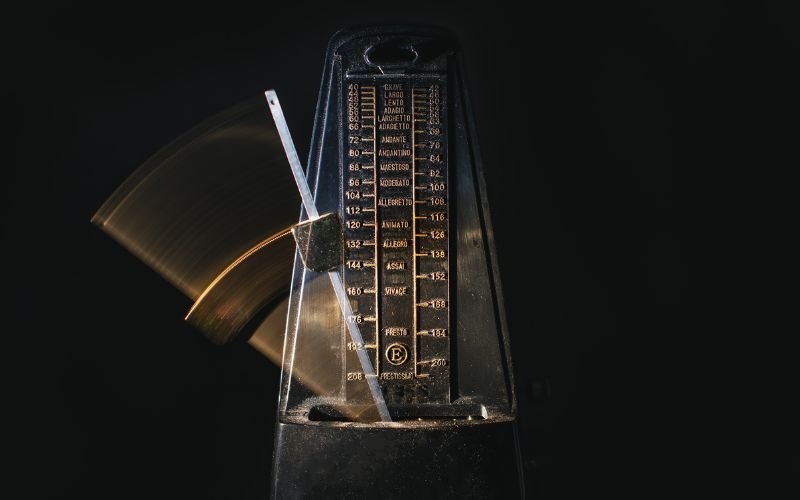What is an ostinato in music?
In music, certain elements transcend time and genre, leaving an indelible imprint on the way we perceive and create songs.
Originating in Italy, the term "ostinato" evokes a perseverance of action, a rhythmic obstinacy of a theme that persists throughout a musical work. With its repetition of a rhythmic, melodic or harmonic formula, the ostinato is one of these timeless elements.
Newzik deciphers the concept of ostinato through its history and influence on various musical genres. It's an opportunity to note that the musical theme of the ostinato is still very much present and important in today's popular music!
Ostinato: the repetition of a rhythmic or melodic formula
Etymology and early ostinatos
According to the official Larousse definition, ostinato represents "a melodic or rhythmic motif repeated obstinately, usually in the bass, in a work".
An Italian term, ostinato translates as "stubborn", meaning perseverance through thick and thin. Like an obstinate person, ostinato is the incessant repetition of a melody throughout a piece. Despite musical variations, the repeated rythm of the ostinato is maintained without interruption between the beginning and end of a work.
The very first ostinato tunes date back to the XIIIᵉ century. In 17th-century England, ostinato was known as Ground Bass. One of the most famous ostinatos is that of the dance called La Folia, in which the theme has been taken up by numerous composers since its creation.
Melodic ostinato and rhythmic ostinato
Solfeggio and rythm teach us that ostinato repetition can take two different forms:
Rhythmic ostinato: this type of ostinato focuses on the obstinate repetition ofa rhythmic formula, often played by percussion or other rhythmic instruments. The rhythmic ostinato creates a constant, regular pulse that underpins the music, providing a solid anchor for other melodic or harmonic elements.
Melodic ostinato (also known as harmonic ostinato): this type of ostinato refers to a melody or chord progression repeated persistently throughout a piece of music. The melodic or harmonic ostinato can be played by a variety of instruments, and can serve as a recurring motif around which the music develops and evolves.
An example of an ostinato in score
Pachelbel's famous musical theme Canon features eight bars and five chords in a row: D major, A major, B minor, F # minor and G major.
The note D major is the note that launches the theme and returns at the beginning of each bar.
These chords are then repeated to form a repetitive melody until the end of the piece. Here's the sheet music for Canon on the piano:
The ostinato in music history
1600 - 1750: ostinato in the Baroque period
In the 17thᵉ century, the ostinato served as the basis for the construction of a piece of music. One of the best-known examples from the period is Johann Pachelbel's Canon in D major (1680). The ostinato is generally placed in the bass. In Pachelbel's famous canon , the cello performs an ostinato. This work is often taught in secondary schools to illustrate the creation of a canon.
Having become obsolete after 1750, the repetitive technique of the ostinato would not reappear until the XIX and XXᵉ centuries.
Canon by Pachelbel in D
After 1900: "learned" music
From the XXᵉ century onwards, composers gradually began to reuse the ostinato. This was already the case in 1828 with the flute melody played during the entire piece in Maurice Ravel's Bolero. Here, the ostinato is presented at the very beginning of the piece, supported by the same rythm. The notes are then played by the whole orchestra.
Ravel : Bolero
Today, ostinato can be found in all types of popular music
Since the era of Ravel's Bolero, the use of ostinato in music has evolved somewhat.
Now used in all styles of popular music, the ostinato is present in jazz, for example, where it serves as the basis for improvisation. This is the case in Dave Brubeck's Take 5 (1957), where the drums and piano start a tune and the other instruments then improvise a rythm on the theme.
The repetition of rythm can also be found in world music, notably in traditional Indonesian music with the Gamelan instrumental ensemble.
In rock, rap and pop, ostinato exists in the form of a "riff". Michael Jackson's Thriller, Queen's Another One Bites the Dust or Eminem's Lose Yourself: all these songs feature the repetition of a theme with a pattern of bass notes from the beginning to the end of the excerpts.
Dave Brubeck
Do you compose your own music and want to collect your scores in an interactive library? With Newzikimport all your scores, annotate them and transpose them in no time at all. Perfect your melodies wherever you are, thanks to Newzik!


